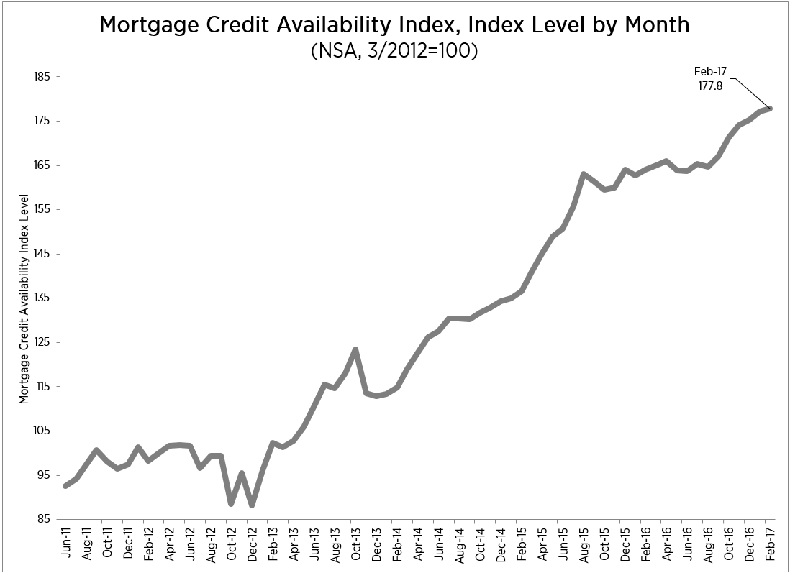WASHINGTON, D.C. (March 10, 2017) RealEstateRama – Mortgage credit availability increased in February according to the Mortgage Credit Availability Index (MCAI), a report from the Mortgage Bankers Association (MBA) which analyzes data from Ellie Mae’s AllRegs® Market Clarity® business information tool.
The MCAI increased 0.4 percent to 177.8 in February. A decline in the MCAI indicates that lending standards are tightening, while increases in the index are indicative of loosening credit. The index was benchmarked to 100 in March 2012. Of the four component indices, the Government MCAI saw the greatest increase in availability over the month (up 2.3 percent), followed by the Conforming MCAI (up 0.1 percent). The Conventional MCAI decreased 2.2 percent while the Jumbo MCAI decreased 4.4 percent.
“Credit availability loosened slightly in February, due to the net result of two countervailing movements. The supply of credit increased as more investors offered affordable low down payment mortgages and streamlined documentation loans guaranteed by the Federal Housing Administration and the Veterans Administration,” said Lynn Fisher MBA’s Vice President of Research and Economics. “However, the impact of that increase on the overall index was partially offset by the first downturn in the availability of jumbo credit in a year due to the consolidation of some jumbo programs.”

Source: Mortgage Bankers Association; Powered by Ellie Mae’s AllRegs® Market Clarity®
CONVENTIONAL, GOVERNMENT, CONFORMING, AND JUMBO MCAI COMPONENT INDICES
Of the four component indices, the Government MCAI saw the greatest increase in availability over the month (up 2.3 percent), followed by the Conforming MCAI (up 0.1 percent). The Conventional MCAI decreased 2.2 percent while the Jumbo MCAI decreased 4.4 percent.
Source: Mortgage Bankers Association; Powered by Ellie Mae’s AllRegs® Market Clarity®
The Conventional, Government, Conforming, and Jumbo MCAIs are constructed using the same methodology as the Total MCAI and are designed to show relative credit risk/availability for their respective index. The primary difference between the total MCAI and the Component Indices are the population of loan programs which they examine. The Government MCAI examines FHA/VA/USDA loan programs, while the Conventional MCAI examines non-government loan programs. The Jumbo and Conforming MCAIs are a subset of the conventional MCAI and do not include FHA, VA, or USDA loan offerings. The Jumbo MCAI examines conventional programs outside conforming loan limits while the Conforming MCAI examines conventional loan programs that fall under conforming loan limits. The Conforming and Jumbo indices have the same “base levels” as the Total MCAI (March 2012=100), while the Conventional and Government indices have adjusted “base levels” in March 2012. MBA calibrated the Conventional and Government indices to better represent where each index might fall in March 2012 (the “base period”) relative to the Total=100 benchmark.
EXPANDED HISTORICAL SERIES
The Total MCAI has an expanded historical series which gives perspective on credit availability going back approximately 10-years (expanded historical series does not include Conventional, Government, Conforming, or Jumbo MCAI). The expanded historical series covers 2004 through 2010, and was created to provide historical context to the current series by showing how credit availability has changed over the last 10 years – this includes the housing crisis and ensuing recession. Data prior to March 31, 2011, was generated using less frequent and less complete data measured at 6-month intervals and interpolated in the months between for charting purposes. Methodology on the expanded historical series from 2004 to 2010 has not been updated.fts, REITs, Wall Street conduits, life insurance companies and others in the mortgage lending field. For additional information, visit MBA’s Web site: www.mba.org.Regional Account Executive (800) 848-4904 or" target="_blank">
CONTACT
Ali Ahmad
(202) 557- 2727


